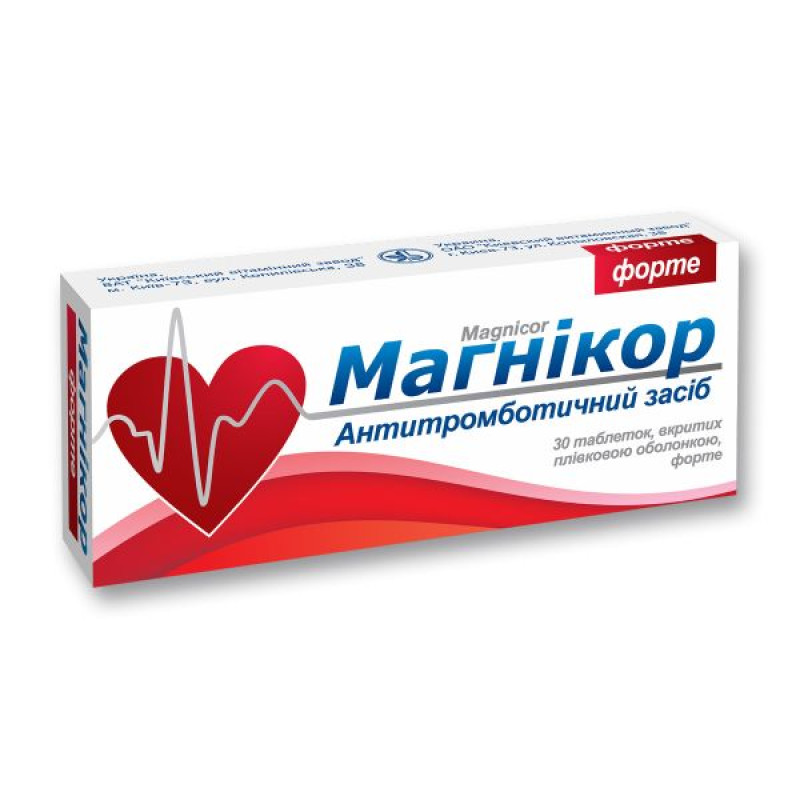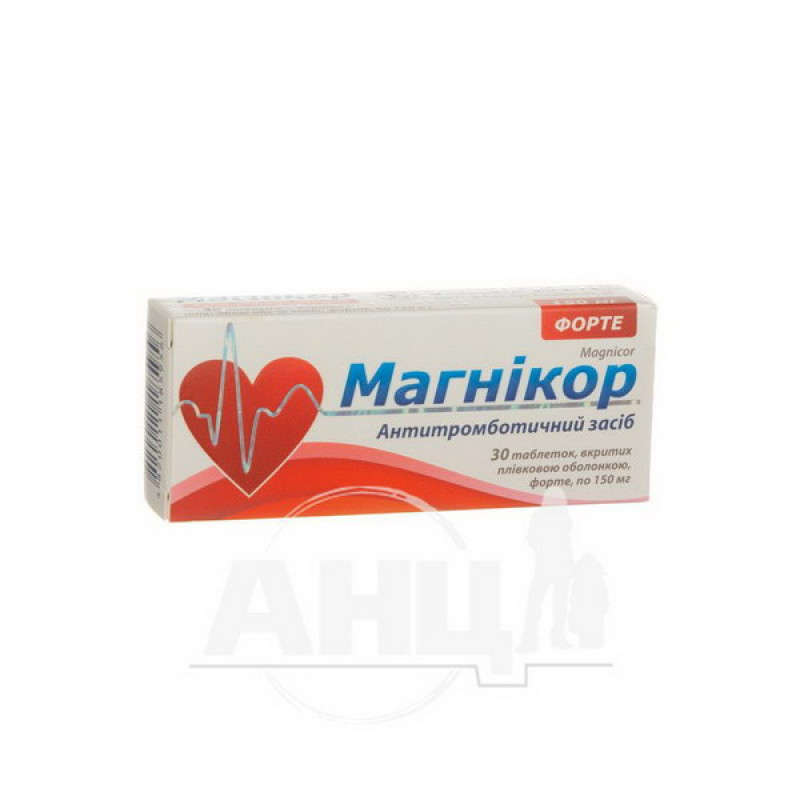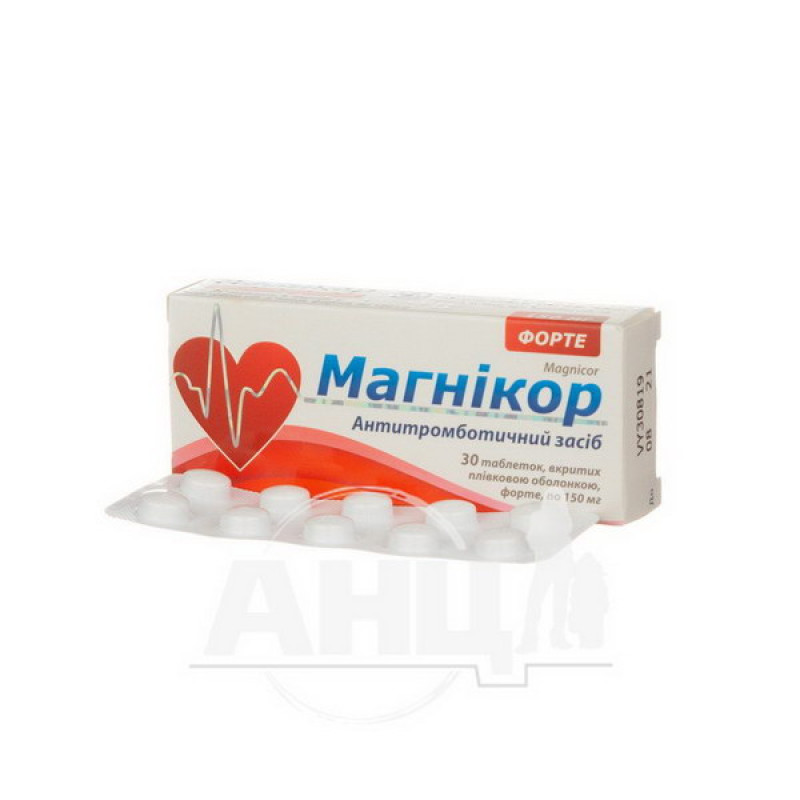Magnicor forte film-coated tablets blister pack No. 30

Pharmacological properties
Pharmacodynamics. Acetylsalicylic acid is an analgesic, anti-inflammatory, antipyretic and antiplatelet agent. Antiplatelet properties increase bleeding time.
The main pharmacological effect is inhibition of prostaglandin and thromboxane formation. The analgesic effect is an additional effect, which is caused by inhibition of the COX enzyme. The anti-inflammatory effect is associated with reduced blood flow caused by inhibition of prostaglandin E2 synthesis.
Acetylsalicylic acid irreversibly inhibits the synthesis of prostaglandins G / H, its effect on platelets lasts longer than acetylsalicylic acid is in the body. The effect of acetylsalicylic acid on the biosynthesis of thromboxane in platelets and on bleeding time continues for a long time after discontinuation of treatment. The effect ceases only after the appearance of new platelets in the blood plasma.
Salicylic acid (the active metabolite of acetylsalicylic acid) has anti-inflammatory effects and also affects respiratory processes, acid-base balance and the mucous membrane of the digestive tract. Salicylates stimulate respiration, mainly by exerting a direct effect on the bone marrow. Salicylates have an indirect effect on the mucous membrane of the digestive tract by inhibiting its vasodilator and cytoprotective prostaglandins and increase the risk of ulcers.
Magnesium hydroxide has an antacid effect and protects the mucous membrane of the digestive tract from the irritating effects of acetylsalicylic acid.
Pharmacokinetics
Absorption. After oral administration, acetylsalicylic acid is rapidly absorbed in the digestive tract. After oral administration, the absorption of the non-ionized form of acetylsalicylic acid occurs in the stomach and intestines. The rate of absorption is reduced by food intake and in patients with migraine attacks, and is reduced in patients with achlorhydria or in individuals taking polysorbates or antacids. C max in serum is reached after 1-2 hours.
When taken orally, magnesium is slowly absorbed in small amounts in the small intestine.
Distribution. The binding of acetylsalicylic acid to plasma proteins is 80-90%. The volume of distribution for adults is 170 ml/kg body weight. With increasing plasma concentration, saturation of the active sites of proteins occurs, which leads to an increase in the volume of distribution. Salicylates are extensively bound to plasma proteins and are rapidly distributed throughout the body. Salicylates penetrate into breast milk and can penetrate the placental barrier. Magnesium is distributed with proteins in a bound form (approximately 25-30%). A small amount penetrates into breast milk. Magnesium can penetrate the placental barrier.
Metabolism: Acetylsalicylic acid is hydrolyzed to the active metabolite, salicylic acid, in the stomach wall. After absorption, acetylsalicylic acid is rapidly converted to salicylic acid, but within the first 20 minutes after oral administration it is dominant in the blood plasma.
Excretion. Salicylic acid is metabolized mainly in the liver. Thus, the equilibrium concentration of salicylic acid in the blood plasma increases disproportionately to the dose taken. At a dose of 325 mg of acetylsalicylic acid, excretion occurs with the participation of first-order reaction kinetics. T ½ is 2-3 hours. At a high dose of acetylsalicylic acid, T ½ increases to 15-30 hours. Salicylic acid is also excreted unchanged in the urine. The excreted volume of salicylic acid depends on the dose level and urine pH. Approximately 30% of the salicylic acid dose is excreted in the urine if the urine reaction is alkaline, only 2% - if acidic. Excretion through the kidneys occurs due to the processes of filtration, active secretion of the renal tubules and passive tubular reabsorption.
A small amount of magnesium is excreted in the urine, but most is reabsorbed and excreted in the feces.
Indication
Acute and chronic coronary artery disease.
Application
The recommended dose is 1 tablet (150 mg / 30.39 mg) per day.
Swallow the tablets whole, with water if necessary. To ensure rapid absorption, the tablet can be chewed or dissolved in water.
Hepatic impairment. The drug should not be used in patients with severe hepatic impairment. Dosage adjustment may be necessary in individuals with hepatic impairment.
Renal impairment. The drug should not be used to treat patients with severe renal insufficiency (glomerular filtration rate 0.2 ml / s (10 ml / min)). Dose adjustment may be necessary in patients with renal impairment.
Contraindication
Hypersensitivity to acetylsalicylic acid, other salicylates or any component of the drug. history of urticaria caused by the use of salicylates or substances with a similar effect, especially non-steroidal anti-inflammatory drugs. acute peptic ulcers. hemorrhagic diathesis. severe renal failure. severe hepatic failure. severe heart failure. combination with methotrexate at a dose of ≥15 mg/week (see interactions).Side effects
Due to its antiplatelet effect on platelets, acetylsalicylic acid may be associated with a risk of bleeding, prolongation of bleeding time. Bleeding such as perioperative hemorrhage, hematomas, bleeding from the genitourinary system, epistaxis, bleeding from the gums have been reported; rarely or very rarely, serious bleeding such as gastrointestinal hemorrhage, cerebral hemorrhage (especially in patients with uncontrolled hypertension and/or concomitant use of antihemostatic agents), which in some cases could be potentially life-threatening.
Hemorrhages can lead to acute and chronic posthemorrhagic anemia/iron deficiency anemia (due to so-called hidden microbleeding) with corresponding laboratory manifestations and clinical symptoms, such as asthenia, pallor of the skin, hypoperfusion.
Hemolysis and hemolytic anemia have been reported in patients with severe forms of glucose-6-phosphate dehydrogenase deficiency.
Renal dysfunction and acute renal failure have been reported.
Hypersensitivity reactions with appropriate laboratory and clinical manifestations, including asthmatic status, mild to moderate skin reactions, as well as from the respiratory tract, gastrointestinal tract and cardiovascular system, including symptoms such as rash, urticaria, edema, itching, rhinitis, nasal congestion, cardiorespiratory failure and very rarely - severe reactions, including anaphylactic shock.
Very rarely, transient hepatic failure with increased transaminase and LF levels in plasma has been reported.
Dizziness and ringing in the ears have been reported, which may indicate an overdose.
Special instructions
The drug Magnicor should be used with caution in the following situations:
hypersensitivity to analgesics, anti-inflammatory, antirheumatic drugs, as well as in the presence of allergies to other substances; gastrointestinal ulcers, including chronic and recurrent ulcers, or gastrointestinal bleeding in history; simultaneous use of anticoagulants; in patients with impaired renal function or in persons with impaired cardiovascular circulation (for example, renal vascular pathology, congestive heart failure, hypovolemia, major surgery, sepsis or severe bleeding), since acetylsalicylic acid may also increase the risk of impaired renal function and acute renal failure; in patients with severe glucose-6-phosphate dehydrogenase deficiency, acetylsalicylic acid may cause hemolysis or hemolytic anemia. Especially in the presence of factors that may increase the risk of hemolysis, such as high doses of the drug, fever or acute infectious process; impaired liver function.Ibuprofen may reduce the inhibitory effect of acetylsalicylic acid on platelet aggregation. In the case of using Magnicor, the patient should consult a doctor before starting to use ibuprofen as an analgesic.
Acetylsalicylic acid may cause bronchospasm or asthma attacks, or other hypersensitivity reactions. Risk factors include a history of asthma, hay fever, nasal polyps or chronic respiratory disease, and a history of allergic reactions (e.g. skin reactions, itching, urticaria) to other substances.
Due to the inhibitory effect of acetylsalicylic acid on platelet aggregation, which persists for several days after administration, the use of medicines containing acetylsalicylic acid may increase the likelihood/increase bleeding during surgical operations (including minor surgical interventions, such as tooth extraction).
When using acetylsalicylic acid in low doses, the excretion of uric acid may decrease. This may lead to an attack of gout in patients prone to it.
Do not use medicines containing acetylsalicylic acid in children and adolescents with acute respiratory viral infections, with or without fever, without consulting a doctor. With some viral diseases, especially influenza A, influenza B and chickenpox, there is a risk of developing Reye's syndrome, which is a very rare but life-threatening disease that requires urgent medical intervention. The risk may be increased if acetylsalicylic acid is used as a concomitant medicine, but a causal relationship in this case has not been proven. If these conditions are accompanied by persistent vomiting, this may be a manifestation of Reye's syndrome.
The available epidemiological data on the occurrence of malformations are not consistent, but an increased risk of gastroschisis cannot be excluded with the use of acetylsalicylic acid. The available data on its effects in early pregnancy (1-4 months) do not indicate any association with an increased risk of malformations.
Animal studies indicate reproductive toxicity.
In the first and second trimesters of pregnancy, medicines containing acetylsalicylic acid should not be prescribed unless clearly necessary. For women who may be pregnant or in the first and second trimesters of pregnancy, the dose of medicines containing acetylsalicylic acid should be as low as possible and the duration of treatment as short as possible.
In the third trimester of pregnancy, all prostaglandin synthesis inhibitors can affect the fetus in the following ways:
Cardiopulmonary toxicity (with premature closure of the ductus arteriosus and pulmonary hypertension); renal dysfunction with possible further development of renal failure with oligohydramnios.Prostaglandin synthesis inhibitors can affect a woman and her baby in the following ways at the end of pregnancy:
possibility of prolongation of bleeding time, antiplatelet effect, which may occur even after taking the drug in very low doses; inhibition of uterine contractions, which may lead to a delay or increase in the duration of labor.Given this, acetylsalicylic acid is contraindicated in the third trimester of pregnancy.
Salicylates and their metabolites pass into breast milk in small quantities.
Since no harmful effects of the drug on the child have been identified after use in women during lactation, it is usually not necessary to interrupt breastfeeding. However, in cases of regular use or when using the drug in high doses, breastfeeding should be discontinued at an early stage.
Children. According to the indications (see Method of administration), the drug should not be used in children. The use of acetylsalicylic acid in children under 15 years of age can cause severe side effects (including Reye's syndrome, one of the signs of which is persistent vomiting).
The ability to influence the reaction rate when driving vehicles or working with other mechanisms. Does not affect.
Interactions
Contraindications for concomitant use
Methotrexate. The use of acetylsalicylic acid and methotrexate at a dose of ≥15 mg/week increases the hematological toxicity of methotrexate (reduction in renal clearance of methotrexate by anti-inflammatory agents and displacement of methotrexate from plasma protein binding by salicylates).
ACE inhibitors. ACE inhibitors in combination with high doses of acetylsalicylic acid cause a decrease in glomerular filtration due to inhibition of the vasodilator effect of prostaglandins and a decrease in the antihypertensive effect.
Acetazolamide: Possible increase in acetazolamide concentrations may lead to the penetration of salicylates from plasma into tissue and cause acetazolamide toxicity (fatigue, lethargy, drowsiness, confusion, hyperchloremic metabolic acidosis) and salicylate toxicity (vomiting, tachycardia, hyperpnea, confusion).
Probenecid, sulfinpyrazone. When probenecid is used with high doses of salicylates (500 mg), the metabolism of both drugs is inhibited and uric acid excretion may be reduced.
Combinations to be used with caution
Methotrexate. When using acetylsalicylic acid and methotrexate at doses of 15 mg/week, the hematological toxicity of methotrexate increases (reduction in renal clearance of methotrexate by anti-inflammatory agents and displacement of methotrexate from plasma protein binding by salicylates).
Clopidogrel, ticlopidine. The combined use of clopidogrel and acetylsalicylic acid has a synergistic effect. Such combined treatment should be continued with caution, as it increases the risk of bleeding.
Anticoagulants (warfarin, phenprocoumon). Thrombin production may be reduced, resulting in an indirect effect on platelet activity (vitamin K antagonist) and an increased risk of bleeding.
Abciximab, tirofiban, eptifibatide. Possible inhibition of glycoprotein IIb/IIIa receptors on platelets, leading to an increased risk of bleeding.
Heparin: May reduce thrombin production, resulting in an indirect effect on platelet activity, leading to an increased risk of bleeding.
If two or more of the above substances are used together with acetylsalicylic acid, this may lead to a synergistic effect of increased inhibition of platelet activity and, as a result, to an increase in hemorrhagic diathesis.
NSAIDs and COX-2 inhibitors (celecoxib). Concomitant use increases the risk of gastrointestinal disorders, which may lead to gastrointestinal bleeding.
Patients who use acetylsalicylic acid once a day for the prevention of cardiovascular disease and occasionally take ibuprofen should take acetylsalicylic acid at least 2 hours before taking ibuprofen.
Furosemide: Inhibition of proximal tubular elimination of furosemide is possible, leading to a decrease in the diuretic effect of furosemide.
Quinidine: May have an additive effect on platelets, leading to prolonged bleeding time.
Spironolactone: A modified renin effect is possible, leading to a decrease in the effectiveness of spironolactone.
Selective serotonin reuptake inhibitors: Concomitant use increases the risk of gastrointestinal disorders, which may lead to gastrointestinal bleeding.
Valproate. When used simultaneously with valproate, acetylsalicylic acid displaces it from its association with blood plasma proteins, increasing the toxicity of the latter (central nervous system depression, gastrointestinal disorders).
Systemic corticosteroids (excluding hydrocortisone, which is used for replacement therapy in Addison's disease) reduce the level of salicylates in the blood and increase the risk of overdose after the end of treatment.
Antidiabetic drugs: Concomitant use of acetylsalicylic acid and antidiabetic drugs increases the risk of hypoglycemia.
Antacids. Possible increase in renal clearance and decrease in renal absorption (due to increased urine pH), which leads to a decrease in the effect of acetylsalicylic acid. The clinical significance of the interaction of acetylsalicylic acid and magnesium is minimal due to the small amount of magnesium contained in the drug.
Varicella vaccine. Concomitant use increases the risk of Reye's syndrome.
Ginkgo biloba. Concomitant use with ginkgo biloba inhibits platelet aggregation, which leads to an increased risk of bleeding.
Digoxin. When used simultaneously with digoxin, the concentration of the latter in the blood plasma increases due to a decrease in renal excretion.
Alcohol contributes to damage to the gastrointestinal mucosa and prolongs bleeding time due to the synergism of acetylsalicylic acid and alcohol.
Overdose
toxicity
Dangerous dose: Adults: 300 mg/kg body weight.
Chronic salicylate poisoning can be insidious because its signs and symptoms are nonspecific. Moderate chronic salicylate intoxication, or salicylism, is usually noted only after repeated high-dose administration.
Symptoms. Symptoms of chronic moderate poisoning (resulting from prolonged use of the drug in high doses): dizziness, vertigo, deafness, increased sweating, fever, rapid breathing, tinnitus, respiratory alkalosis, metabolic acidosis, lethargy, moderate dehydration, headache, confusion, nausea and vomiting.
Acute intoxication is indicated by a pronounced change in the acid-base balance, which may vary depending on age and severity of intoxication. Its most frequent manifestation in children is metabolic acidosis. The severity of the condition cannot be assessed solely on the basis of data on the concentration of salicylates in the blood plasma. The absorption of acetylsalicylic acid may be slowed down due to delayed gastric emptying, the formation of concrements in the stomach or when it is used in the form of enteric-coated tablets.
Symptoms of severe and acute poisoning (due to overdose): hypoglycemia (mainly in children), encephalopathy, coma, hypotension, pulmonary edema, convulsions, coagulopathy, cerebral edema, cardiac arrhythmias.
A more pronounced toxic effect is observed in patients with chronic overdose or abuse of the drug, as well as in the elderly or children.
Treatment: In case of acute overdose, gastric lavage and administration of activated charcoal are necessary. If a dose of 120 mg/kg body weight is suspected, activated charcoal should be administered again.
Serum salicylate levels should be measured at least every 2 hours after dosing until salicylate levels are consistently reduced and acid-base balance is restored.
Prothrombin time and/or international normalized ratio should be checked, particularly if bleeding is suspected.
It is necessary to restore the balance of fluids and electrolytes. Effective methods of removing salicylate from the blood plasma are alkaline diuresis and hemodialysis. Hemodialysis should be used in case of severe intoxication, since this method significantly accelerates the elimination of salicylate and restores the acid-base and water-salt balances.
Due to the complex pathophysiological effects of salicylate poisoning, signs and symptoms/test results may include:
| Mild or moderate intoxication | Gastric lavage, repeated administration of activated charcoal, forced alkaline diuresis | |
| Tachypnea, hyperventilation, respiratory alkalosis | Alkalemia, alkaluria | Restoration of electrolyte and acid-base balance |
| Diaphoresis (increased sweating) | ||
| Nausea and vomiting | ||
| Moderate or severe intoxication | Gastric lavage, repeated administration of activated charcoal, forced alkaline diuresis, hemodialysis in severe cases | |
| Respiratory alkalosis with compensatory metabolic acidosis | Acidemia, aciduria | Restoration of electrolyte and acid-base balance |
| hyperpyrexia | Restoration of electrolyte and acid-base balance | |
| Respiratory: hyperventilation, noncardiogenic pulmonary edema, respiratory failure, asphyxia | ||
| Cardiovascular: dysarrhythmia, hypotension, cardiovascular failure | Changes in blood pressure, ECG | |
| Fluid and electrolyte loss: dehydration, oliguria, renal failure | Hypokalemia, hypernatremia, hyponatremia, changes in renal function | Restoration of electrolyte and acid-base balance |
| Impaired glucose metabolism, ketoacidosis | Hyperglycemia, hypoglycemia (especially in children). Elevated ketone bodies | |
| Ringing in the ears, deafness | ||
| Gastrointestinal: bleeding | ||
| Hematologic: platelet inhibition, coagulopathy | Prolongation of prothrombin time, hypoprothrombinemia | |
| Neurological: toxic encephalopathy and CNS depression with manifestations such as lethargy, confusion, coma, and seizures | ||
Storage conditions
At a temperature not exceeding 25 °C.
There are no reviews for this product.
There are no reviews for this product, be the first to leave your review.
No questions about this product, be the first and ask your question.








